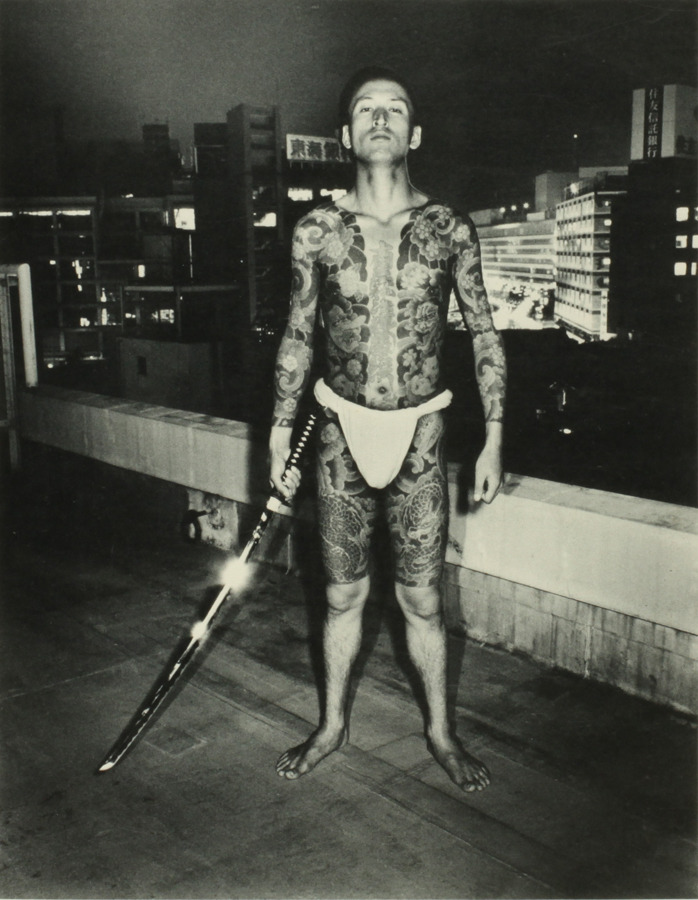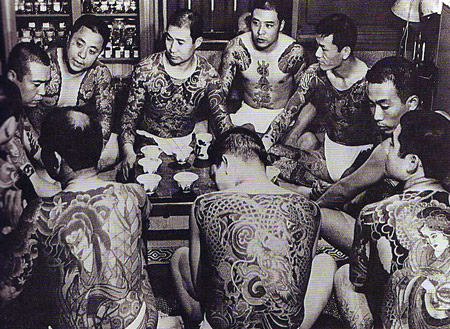This week’s article will be focusing on Irezumi (a style of tattoo), Pearling, self mutilation and its connections with the Japanese underground crime organisations called the Yakuza.
(One might ask if Yakuza can be considered a subculture; I’m not sure of that myself, but this blog more interested in the body modifications they practice as a group, which include sporting Irezumi tattoos, self mutilation by cutting off their fingers and penile implants (although called pearling, can also be a form of subdermal implant))
Disclaimer: this article might have some ‘shock’ value to it.


I first came to know about the Yakuza through the pioneering work on body modifications, Modern Primitives by REsearch publications body modifcation. It was an article about male genital subdermal implants; they were probably interested in 'modern' body modification practiced outside the US, and the article was trying to show what 'pearling' was- the insertion of pearls underneath the skin of the shaft of the penis.
The article states that this was practiced by Yakuza members who've been in jail, although actually there have been accounts of this done among inmates in western countries as well
“Men who have been in the Yakuza often go to prison for various reasons- these are the lower class that take the fall for their boss. And in prison they do these penile implants- take a pearl and insert it under their skin for every year they’ve been in jail… they carve down a chopstick or toothbrush to a very sharp point, split the skin...lift the skin up and away, insert the pearl and then bandage it so the skin heals over and the area resembles a really big wart!” (Vale, 156-157) (actual origins of this practice are as yet unclear)
“Men who have been in the Yakuza often go to prison for various reasons- these are the lower class that take the fall for their boss. And in prison they do these penile implants- take a pearl and insert it under their skin for every year they’ve been in jail… they carve down a chopstick or toothbrush to a very sharp point, split the skin...lift the skin up and away, insert the pearl and then bandage it so the skin heals over and the area resembles a really big wart!” (Vale, 156-157) (actual origins of this practice are as yet unclear)


Another, though admittedly less 'extreme' form of body modification which stylistically is attributed to Japan is the Irezumi tattoo- that is, Japanese styled tattoos which are meant to cover a large part of body area eg. upper arms, torso, limbs etc. and have specific placement and style (Themes particular to japan like Samurai, Geisha, cherry blossom, wave patterns etc) to it. Traditionally, these tattoos are collected over many years and are hand carved into the skin, but this has been overshadowed in favor of the electric tattoo needle method of late, and tattoos are faster to complete.
What Pearling and Irezumi have in common is the fact that these two modifications are found to be practiced among those who are members of the Yakuza- the Japanese 'underground' mafia who actually have alot of control in Japan. V.Vales interview in Modern Primitives perhaps gives an explanation as to why they sport these modifications
In terms of looking at “form, content and function” in Yakuza ‘style’ through objects and practices, the two are difficult to connect.
Other than the self mutilation of shopping off their fingers, Irezumi and subdermal implanting are merely cultural practices adopted by the Yakuza- not everyone sporting Irezumi or Pearling belong to Yakuza,for example, even though Irezumi has an 'underground' status, it is one of the less popular tradition of body art that Japan has. Especially also since the popularity of Irezumi has spread, in recent times, out of the the Japanese culture. In fact, Horiyoshi III, a renowned Irezumi tattoo artist, exchanged tattoo styles and ideas with Don Ed Hardy, who introduced him to modern tattooing methods. (Nothing to do with Yakuza in particular, just find this point interesting - nothing is ever isolated)
However, perhaps a link can be drawn between a Yakuza member's 'hidden' body modifications, for they are careful not to show their tattoos in public and the fact that they (traditionally) operate underground. So its the whole 'unseen but still there' element to it? Furthermore take into consideration that Japanese culture till today is largely unaccepting of tattoos, and visible tattoos impede one's ability to get an office job, another important aspect in Japanese society. The careful placement of Irezumi means that it can be covered up with long sleeved shirt and long pants - on the streets, unless one was observing very carefully you may or may not even know if a person has Irezumi. However, the distinct style of the tattoo also has its connotations and perhaps gives the wearer a sense of identity with the gang he's associated with.
Form
|
Content
|
Function
| |
Objects
|
Irezumi Tattoo
|
Traditional Japanese themes selected from myths, legends and Japanese symbology
|
For men:
To prove manliness - able to withstand the pain of being tattooed (According to Hiroyoshi)
As a way to identify Yakuza members (according to Heather Macdonald) |
Self mutilation
|
Sign of repentance toward bosses if something goes wrong
|
Prove loyalty to group and boss
| |
Pearling (genital beading)
|
Subdermal implants of beads/ pearls along the genitals
|
Signify how many years spent in jail, by way of distinguishing oneself, perhaps?
| |
Practices
|
Organised Crime
|
Political connections, Gambling, Skin trade, manipulation of stock market etc
|
Gain wealth and power for organisation
|
Homology of the Yakuza
Ideology
Because the Yakuza organisations are hierarchical, the ‘big bosses’ and leaders of the organisations tend to hold white collar, executive, managerial positions, while their underlings are recruited from the ‘working’ or ‘blue collar’ class, recruited from juvenile delinquents or japanese biker gangs- the agenda of being on the wrong side of the law is present from the start
Objects
It is difficult to recognize Yakuza outwardly, since they hide their Irezumi Tattoos with the clothes the wear, and prosthetics to replace missing fingers, genital implants will not be seen by the public.
Practices:
Dominating the underground scene, gambling, organised crime through political and economic manipulation, and ‘protection money’ collecting.
I think it is difficult to say in the end if the 'style' and practices are directly relational- certainly body modifications are hardly indicative of crimminal behaviour- it just seems like for some reason through stereotypes, or the fact that the Yakuza have appropriated these 'objects' in the culture so significantly that one thinks of 'yakuza' when they see or come into contact with an 'Irezumi' reference, although for me personally I would associate the pearling and self mutilation more with the undergorund denizens just because the tattoo culture of Irezumi seems to have manifested in many different forms these days and so many other people wear it- but this also comes from a more global context, perhaps in Japan where tattoos are still highly disapproved of does it have stronger associations with the Yakuza.
Links and Sources
Vale, V. Juno, Andrea. Heather Macdonald, Modern Primitives. RE/Search. San Fransico. 1989. (p 156, 157)
For more Irezumi Images:
http://artofirezumi.tumblr.com/
http://fuckyeahirezumi.tumblr.com
Some Writing about Irezumi
http://tattoo.yoso.eu/oriental-irezumi-and-occidental-tattooing-in-contemporary-japan
http://www.globalpost.com/dispatch/news/regions/asia-pacific/japan/130502/yakuza-fukuoka-gang-wars
Journal Articles:


No comments:
Post a Comment